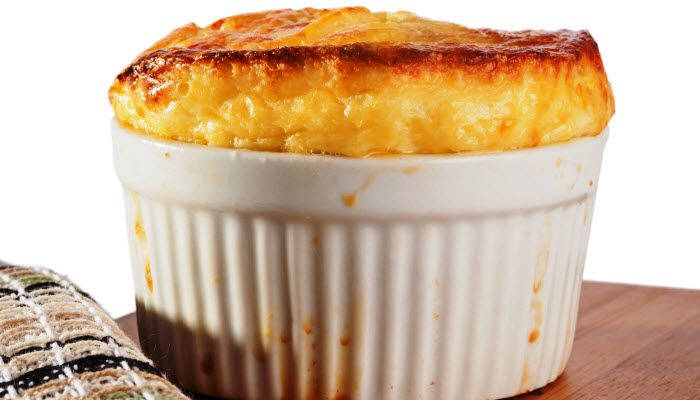Is A Soufflé An Entree?
What is a Souffle?
A soufflé is a baked egg-based dish that originated in early 18th century France. According to the Merriam-Webster dictionary, the definition of a soufflé is “a dish that is made from a sauce, egg yolks, beaten egg whites, and a flavoring or purée (as of seafood, fruit, or vegetables)” [1].
The earliest known recipe for soufflé appeared in French chef Vincent La Chapelle’s treatise “The Modern Cook” in 1733. However, the dish did not gain widespread popularity until the 19th century [2].
The base of a soufflé is typically a flavorful béchamel or velouté sauce to which egg yolks and flavorings are added. Stiffly beaten egg whites are then carefully folded into the base to incorporate air and allow the soufflé to puff up when baked. Common savory flavors include cheese, seafood, vegetables, and smoked meat. Sweet soufflés may incorporate chocolate, fruit, nuts, or liquor. The light and airy texture of a properly executed soufflé is its hallmark.
Types of Savory Souffles
Savory souffles make for an elegant and impressive dish, whether served as a first course, side dish, or light entrée. There are many delicious options when it comes to savory souffle recipes.
Cheese is one of the most popular ingredients used in savory souffles. Some classic options include:
- Gruyere Souffle – Often made with Swiss or French Gruyere cheese for a nutty, rich flavor.
- Cheddar Souffle – Sharp cheddar gives these souffles a tangy bite.
- Goat Cheese Souffle – The creamy tang of goat cheese pairs well with herbs and spinach.
In addition to cheese, vegetables make excellent savory souffle fillings. Some examples include:
- Spinach Souffle – Packed with vitamin A, iron, and antioxidants from fresh spinach.
- Broccoli and Cheddar Souffle – A tasty combination of veggies and cheese.
- Corn Souffle – Sweet kernels elevate this side dish souffle.
Savory souffles can also be made with various meats. Chicken, turkey, ham, and seafood all work well, such as:
- Chicken and Mushroom Souffle – Shredded chicken and sautéed mushrooms give this a meaty texture.
- Salmon Souffle – Fluffy and elegant, with smoked salmon adding a pop of color.
- Prosciutto and Parmesan Souffle – The saltiness of cured ham balances the Parmesan.
The possibilities are endless when making savory souffles. Feel free to experiment with ingredients like roasted veggies, bacon, herbs, and different cheese varieties.
Sweet vs Savory Souffles
There are some key differences between sweet and savory souffles that set them apart in terms of flavor profile and preparation. According to Mashed, “The eggy desserts are oftentimes accompanied by crème Anglaise or a berry sauce. Savory soufflés can feature cheese, vegetables, or even meat.”
The main ingredients distinguish sweet from savory souffles. Sweet souffles contain sugar, chocolate, fruit or extracts like vanilla or almond. Savory souffles rely on cheese, vegetables, herbs or spices for flavor. Sweet souffles get their rise from beaten egg whites folded into a yolk-sugar base. Savory souffles incorporate whipped egg whites into a roux-based sauce.
There are also differences in preparation. As noted in The Oklahoman, “Sweet souffles are baked in buttered dishes coated with granulated sugar, while savory versions such as cheese souffles are prepared in buttered dishes without the added sugar.” The cooking vessel impacts the texture and rise. Sweet souffles have a delicate crust from the caramelized sugar. Savory souffles have a softer exterior without the sugar.
Finally, sweet and savory souffles pair well with different sauces and sides. Sweet souffles are often served with a sauce like chocolate, fruit compote or crème anglaise. Savory souffles pair nicely with vinaigrettes, creamy vegetable purees or pan sauces. The accompaniments match the overall flavor profile.
Souffles as an Appetizer or Side Dish
Souffles are traditionally served before the main course as a light appetizer or first course. Their airy, fluffy texture makes them an ideal starter to whet the appetite before a larger entree. According to Garlic Parmesan Souffle Recipe – What’s Cooking America, souffles have a delicate, subtle flavor that serves as a perfect introduction to a meal.
While most commonly enjoyed as an appetizer, souffles can also shine as Soufflé – Wikipedia states that side dishes alongside an entree. Their adaptable nature allows souffles to be flavored either savory or sweet to complement the main course. A small ramekin of a rich cheese souffle or sweet chocolate souffle pairs nicely next to a protein-based main dish.
Souffles as a Main Course
Although souffles are often served as a first course or side dish, some chefs also prepare them as hearty main dishes. Large individual souffles can make a satisfying entree when filled with cheese, vegetables, or meat. According to The Spruce Eats, popular options for souffles as a main course include spinach and goat cheese, salmon, and ham and cheese versions.

When making a souffle substantial enough to serve as an entree, it’s important to add extra ingredients like diced vegetables, meat, or seafood. The base of eggs, milk and cream cheese or bechamel sauce provides richness, while the added proteins and produce make it more filling. Potatoes, cauliflower, broccoli, tuna, chicken and mushrooms all work well mixed into souffle batter.
To serve a souffle as a main dish, opt for individual sized ramekins rather than one large souffle dish. This ensures proper portion size as an entree, and also allows for customized fillings if making multiple souffles. Mini souffles in ramekins also have an attractive presentation when served for dinner guests.
Nutrition Profile
Soufflés are a light and fluffy baked dish that can be either savory or sweet. Though soufflés have a reputation for being high in calories and fat, they can actually be quite nutritious if made properly.
The nutrition profile of a soufflé depends greatly on the specific ingredients used. For example, a cheese soufflé made with eggs, milk, flour, and cheese contains about 194 calories per 95 gram serving. It provides 15 grams of fat, 9 grams of protein, and 6 grams of carbohydrates including 2.3 grams of sugar.
Soufflés can provide a good amount of vitamins and minerals. Eggs contribute vitamin A, vitamin B12, riboflavin, selenium, and choline. Milk provides calcium, vitamin D, and vitamin B12. Vegetables add vitamins like vitamin C, vitamin K, potassium, and folate when included in the base.
To make soufflés healthier, opt for low fat dairy, egg whites instead of whole eggs, and plenty of fresh vegetables. Avoid adding excessive butter, cream, or cheese. Portion control is also key – a serving of soufflé is just a few ounces.
Making Souffles Light and Healthy
Souffles are often associated with heavy cream, cheese, and egg yolks, but there are easy ways to lighten up this dish for a healthier meal.
One strategy is to substitute lower-fat ingredients while retaining the airy, fluffy texture. For instance, using egg whites instead of whole eggs cuts back on saturated fat and cholesterol. Skim or low fat milk can replace heavy cream. And reduced fat cheese or pureed veggies like cauliflower or spinach make a nourishing alternative to full-fat cheese (Source).
Portion size is another important consideration when enjoying souffles. A 1⁄2 cup serving of a spinach or vegetable souffle contains around 100-150 calories, while a chocolate or cheese souffle may have closer to 250 calories per serving. Focusing on side dish or appetizer-sized portions keeps indulgent souffles in balance (Source).
With smart substitutions and proper portion sizes, souffles can be part of a healthy, balanced diet.
Tips for Perfect Souffles
Making the perfect souffle requires paying attention to a few key steps.
Beating Egg Whites Properly
Beating the egg whites properly is crucial for getting the right airy texture in a souffle. Use a clean metal or glass bowl for whipping the egg whites. Make sure no yolk, grease, or oil gets into the whites, as it will prevent them from whipping properly. Whip the egg whites with a hand or stand mixer until they form soft peaks. Overbeating can cause the souffle to collapse, so stop mixing once the peaks form [1].
Folding in Egg Whites
Gently fold the whipped egg whites into the souffle base using a rubber spatula. Fold in the egg whites just until incorporated, being careful not to deflate the air you whipped into them. Folding gently prevents the souffle from sinking when baked [1].
Using the Right Bakeware
Bake the souffle in straight-sided ramekins or souffle dishes. Make sure the dishes are oven-safe. Butter the dishes well and coat with sugar or cheese before adding the souffle batter. The coating helps the souffles rise up the sides of the dishes. Avoid any cracks or flaws in the baking dishes. Serve the souffle immediately in the same ramekins for the best presentation [1].
Storing and Reheating Souffles
Properly storing and reheating leftover soufflés is important for maintaining their light, airy texture. Here are some tips:
Refrigerating and freezing: Soufflés hold up well when refrigerated in an airtight container for up to 3 days. They can also be frozen for up to a month. Allow the soufflé to cool completely before refrigerating or freezing.
Microwaving vs oven reheating: Reheating in the oven is preferred to microwaving for best texture. To reheat in the oven, preheat to 350°F and bake the refrigerated soufflé for 8-10 minutes until heated through [1]. Microwaving can make the texture rubbery. If microwaving, use 50% power in 30 second increments just until warmed through.
No matter how you reheat, soufflés won’t quite rise as high as when first baked. But following these tips will help maximize their lift and airy texture.
The Verdict
Based on the classic definitions, souffles are generally not considered entrees. However, they can easily function as a hearty main course when made with protein-rich ingredients and accompaniments. At fancy restaurants, miniature savory souffles are often an appetizer or first course. But at home, a full-sized cheese, seafood, or meat souffle makes a delightful entree when served with a salad or veggies on the side. With practice, souffles are simpler to make than their reputation implies. And their impressive height and delicate texture will make any meal feel special. While not a traditional entree per se, souffles can certainly play the main role in a meal. With the right ingredients and presentation, they satisfy just as well as any center-of-the-plate dish.





